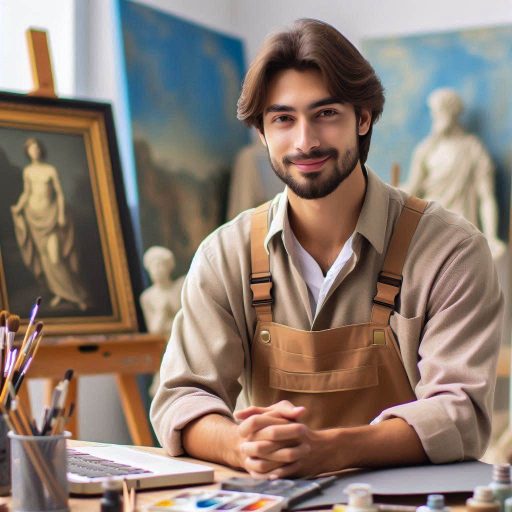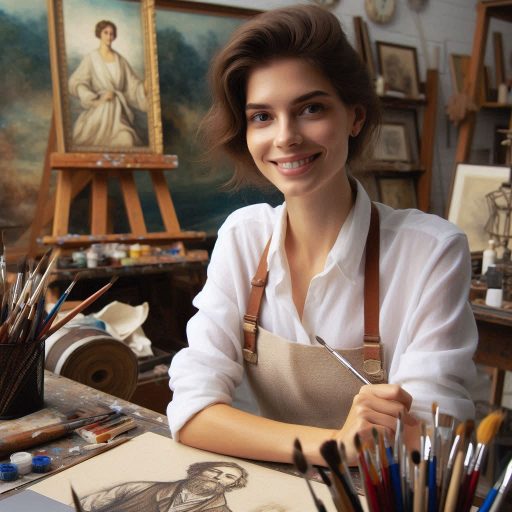Introduction
Art conservation is the practice of preserving and protecting artworks to ensure their longevity.
This field involves a variety of techniques and best practices aimed at maintaining the integrity of art pieces over time.
Artworks, ranging from paintings to sculptures, face various threats.
These include environmental factors, physical damage, and chemical deterioration.
Conservation techniques address these issues by carefully assessing and treating art pieces.
Conservators use specialized tools and methods to stabilize, repair, and prevent further damage.
The importance of art conservation cannot be overstated.
Artworks are cultural treasures that reflect history, society, and individual creativity.
They provide valuable insights into past civilizations and artistic movements.
By preserving these pieces, we maintain a connection to our collective heritage.
Effective conservation ensures that future generations can experience and learn from these artworks.
Proper techniques help prevent the loss of details and historical context.
Additionally, they allow for the continued appreciation of art in its original form.
Implementing best practices in art conservation is crucial.
This includes using appropriate materials and methods tailored to each artwork’s needs.
It also involves regular monitoring and maintenance to address any emerging issues promptly.
Overall, art conservation plays a vital role in safeguarding our cultural legacy.
It enables us to protect and preserve artworks for future appreciation and study.
By following established techniques and practices, we contribute to the ongoing value and relevance of our artistic heritage.
Understanding Art Conservation
The Definition and Purpose of Art Conservation
Art conservation is the practice of preserving and maintaining artworks to ensure their longevity.
Transform Your Career Today
Unlock a personalized career strategy that drives real results. Get tailored advice and a roadmap designed just for you.
Start NowThis field involves assessing the condition of art pieces and applying treatments to stabilize them.
Conservators use scientific techniques and materials to protect art from environmental damage and deterioration.
The purpose is to maintain the artwork’s integrity while allowing future generations to appreciate and study it.
By carefully monitoring and intervening, conservators aim to prevent further damage and preserve historical and cultural values.
The Difference Between Conservation, Restoration, and Preservation
Art conservation, restoration, and preservation are distinct but interrelated processes.
- Conservation involves routine maintenance and repair to prevent deterioration. Conservators focus on stabilizing artworks to ensure they remain in their current state.
- Restoration aims to return an artwork to its original appearance or functionality.
This process often involves repairing or reconstructing damaged parts, using techniques that match the original materials and methods. - Preservation encompasses broader efforts to protect artworks from environmental threats.
It includes controlling factors like light, humidity, and temperature to slow down the natural aging process.
While conservation focuses on maintaining current conditions, restoration seeks to alter or repair, and preservation works to prevent future damage.
Each approach serves a specific purpose in the overall goal of safeguarding cultural heritage.
Understanding these differences helps ensure that artworks are cared for in a manner that respects their historical and artistic significance.
Read: Top Museums Hiring Art Conservators/Restorers
Types of Art Damage
Artworks face various types of damage over time.
Understanding these common issues helps in effective conservation and preservation.
Common types of damage that artworks may face, such as discoloration, tears, and insect infestation
Discoloration is one frequent issue.
Over time, artworks can suffer from fading or yellowing.
This can result from exposure to light, pollutants, or chemical reactions.
Discoloration can alter the original colors and degrade the artwork‘s visual appeal.
It affects the artwork‘s aesthetic and historical value, making accurate restoration more challenging.
Tears are another common type of damage.
Tears can occur due to physical mishandling, aging, or environmental conditions.
They can disrupt the artwork‘s integrity and lead to further deterioration if not addressed promptly.
Proper repair techniques are essential to restore the artwork‘s original appearance and prevent additional damage.
Transform Your Career Today
Unlock a personalized career strategy that drives real results. Get tailored advice and a roadmap designed just for you.
Start NowInsect infestation presents a serious threat.
Insects such as beetles and moths can damage artworks by feeding on organic materials like paper and canvas.
Infestations can lead to holes, fraying, or other structural issues.
This type of damage not only affects the artwork’s condition but can also spread to other pieces if not controlled.
How these damages can affect the overall condition of the artwork
Each of these damage types impacts the overall condition of the artwork.
Discoloration alters the visual aspects and historical accuracy.
Tears compromise structural integrity and visual continuity.
Insect infestations can lead to severe structural damage and loss of material.
Addressing these issues through appropriate conservation techniques is crucial for preserving the artwork‘s value and longevity.
Proper identification and treatment are vital in art conservation.
Understanding how each type of damage affects the artwork helps in choosing the right restoration methods.
This ensures that artworks remain preserved and appreciated for future generations.
Read: How to Start a Career in Art Conservation
Conservation Techniques
Art conservation employs several techniques to preserve and restore valuable artworks.
These techniques include cleaning, stabilization, and inpainting.
Each technique plays a critical role in maintaining the integrity and appearance of artworks.
Various techniques used in art conservation, such as cleaning, stabilization, and inpainting
Cleaning is one of the primary techniques used in art conservation.
It involves removing surface dirt, grime, and accumulated contaminants from artworks.
Conservators use specialized tools and gentle cleaning agents to avoid damaging the artwork.
For instance, the cleaning of a Renaissance painting may require the use of soft brushes and solvent-free solutions to carefully remove dust and dirt without affecting the paint layers beneath.
Transform Your Career Today
Unlock a personalized career strategy that drives real results. Get tailored advice and a roadmap designed just for you.
Start NowStabilization addresses structural issues within artworks.
This technique ensures that the artwork remains intact and prevents further deterioration.
Stabilization methods include repairing tears, reattaching flaking paint, and reinforcing weakened areas.
A notable example is the stabilization of the Dead Sea Scrolls.
Conservators used advanced techniques to stabilize and preserve these ancient manuscripts, ensuring their survival for future generations.
Inpainting involves carefully restoring missing or damaged areas of an artwork.
Conservators use matching pigments and techniques to replicate the original appearance while maintaining the artwork‘s authenticity.
This process requires a deep understanding of the artist’s style and materials.
An example of successful inpainting is the restoration of Leonardo da Vinci‘s ‘The Last Supper.‘
Conservators skillfully inpainted missing sections while preserving the original painting‘s essence and historical value.
Examples of successful conservation projects that showcase these techniques
These techniques, when applied with precision and expertise, help preserve the artistic and historical significance of valuable works.
Successful conservation projects highlight the importance of these methods in maintaining our cultural heritage.
Each project, from cleaning to inpainting, contributes to the lasting legacy of art.
Read: Essential Tools for Art Conservation and Restoration

Best Practices for Art Conservation
Practical tips for preventing damage to artworks, such as proper handling and storage
Effective art conservation begins with proper handling and storage.
Always use gloves when touching artworks to avoid oils and dirt.
Store pieces in a stable environment with controlled temperature and humidity.
Avoid direct sunlight, which can cause fading and deterioration.
For framed works, use acid-free materials to prevent chemical reactions that may damage the art.
Proper handling is crucial.
Transform Your Career Today
Unlock a personalized career strategy that drives real results. Get tailored advice and a roadmap designed just for you.
Start NowWhen moving artwork, use clean, padded surfaces and support the entire piece.
Avoid touching painted surfaces directly.
Use appropriate tools, such as tongs or spatulas, for delicate tasks.
When transporting art, ensure it is securely packaged to prevent shifts or impacts.
For long-term storage, use custom-built archival boxes and avoid stacking items directly on top of each other.
Ensure that the storage area is clean, dry, and free from pests.
Regularly inspect stored artworks for signs of damage or deterioration.
The importance of consulting with professional conservators for complex conservation needs
Consulting with professional conservators is essential for complex conservation needs.
These experts have specialized knowledge and tools for addressing intricate issues.
They can provide tailored solutions that maintain the artwork’s integrity.
Professional conservators are adept at handling historical and valuable pieces, ensuring their preservation for future generations.
When faced with severe damage, such as tears or mold, seek professional help immediately.
Attempting DIY repairs can lead to further harm.
Conservators employ advanced techniques and materials designed to restore and protect art effectively.
Their expertise ensures that conservation efforts align with best practices and ethical standards.
By following these best practices and consulting with experts, you can significantly enhance the longevity and preservation of artworks.
Prioritizing proper handling, storage, and professional advice will safeguard cultural and artistic treasures for years to come.
Read: Skill Sets Employers Seek in US-Based Animation Artists
Conservation Ethics
The ethical considerations involved in art conservation, such as maintaining the integrity of the original artwork
Art conservation involves more than preserving physical artifacts; it also requires navigating complex ethical considerations.
A primary concern is maintaining the integrity of the original artwork.
Transform Your Career Today
Unlock a personalized career strategy that drives real results. Get tailored advice and a roadmap designed just for you.
Start NowConservators must balance the need for preservation with respect for the artist’s original vision.
Each decision made must honor the artwork‘s historical and cultural significance.
Maintaining integrity means avoiding alterations that could distort the artist’s original intent.
This principle guides conservators to use non-invasive techniques whenever possible.
When intervention is necessary, conservators aim to restore rather than replace.
The goal is to ensure that any changes are reversible and minimally invasive.
Another key ethical consideration is transparency.
Conservators must document their methods and materials used during the conservation process.
This documentation ensures that future generations understand the interventions made and can make informed decisions about further treatment if needed.
Clear records help preserve the artwork‘s provenance and conservation history.
The role of conservators in making decisions about intervention and treatment
Conservators also face ethical dilemmas when deciding on the extent of intervention.
Each decision involves weighing the artwork‘s current condition against potential risks of treatment.
For example, should a fragile painting be cleaned if it risks damaging the original pigments? Conservators must assess the potential benefits and harms of any proposed treatment.
The role of conservators extends to consulting with stakeholders, including historians, curators, and even the public.
This collaborative approach helps balance diverse perspectives and ensures that decisions align with the artwork‘s significance.
Conservators strive to make informed, ethical decisions that respect both the physical artifact and its cultural context.
Ultimately, art conservation ethics focus on preserving the artwork‘s authenticity while addressing its needs.
Conservators must navigate these challenges with a deep respect for both the artist’s original work and the future generations who will appreciate it.
Case Studies
Art conservation projects play a crucial role in preserving our cultural heritage.
Let’s take a look at some successful conservation projects and the techniques used:
Transform Your Career Today
Unlock a personalized career strategy that drives real results. Get tailored advice and a roadmap designed just for you.
Start NowThe restoration of The Last Supper by Leonardo da Vinci
This iconic masterpiece was in a deteriorating state due to environmental factors.
The conservation team employed a meticulous cleaning process using a combination of solvents and stabilizers to remove dirt and grime without damaging the original paint.
The conservation of The Scream by Edvard Munch
The famous painting had suffered from water damage and was at risk of further deterioration.
Conservators used innovative techniques like infrared reflectography to analyze the underlying layers of paint and re-stabilize the canvas to prevent future damage.
The preservation of the Terracotta Army in China
This ancient archaeological site faced various challenges such as erosion and environmental pollution.
Conservationists implemented a systematic approach by using specially formulated consolidates to strengthen and protect the delicate terracotta figures from further decay.
The protection of the Great Wall of China
The Great Wall, a UNESCO World Heritage site, required extensive conservation efforts to combat factors like erosion and vandalism.
Conservationists utilized advanced monitoring techniques like drones and satellite imaging to identify vulnerable sections and implement targeted restoration strategies.
The conservation of the Ghent Altarpiece by Hubert and Jan van Eyck
Considered one of the most important artworks in Western art history, the Ghent Altarpiece underwent a comprehensive conservation project to address issues like flaking paint and structural instability.
Conservators used cutting-edge technologies like x-ray fluorescence analysis to understand the composition of the materials and develop specialized treatments for each component.
The restoration of the Statue of Liberty in New York City
This iconic symbol of freedom and democracy required careful conservation to address weathering and corrosion.
Conservation experts used a combination of laser cleaning and protective coatings to remove pollutants and prevent further deterioration, ensuring the statue’s longevity for future generations.
These case studies highlight the critical role of art conservation techniques in safeguarding our shared cultural heritage for future generations.
Discover More: Exhibition Design and Visitor Engagement
Conclusion
We have explored various art conservation techniques and best practices.
These include proper handling, storage, cleaning, and restoration processes.
It is crucial to consider the materials used in artworks when applying conservation methods.
Understanding the materials and techniques used in creating artworks is essential for conservation.
Proper storage conditions such as controlled temperature and humidity levels help prevent deterioration.
Regular cleaning and maintenance of artworks can prolong their lifespan and preserve their original appearance.
Transform Your Career Today
Unlock a personalized career strategy that drives real results. Get tailored advice and a roadmap designed just for you.
Start NowRestoration should be approached cautiously, with the aim of preserving the artist’s intent and historical significance.
Collaboration between conservators, curators, scientists, and artists is vital for successful conservation efforts.
It is important for readers to understand the significance of conservation in preserving our artistic heritage.
By learning more about conservation techniques, individuals can contribute to the protection and longevity of cultural artifacts for future generations to appreciate and study.
Conservation is not only about preserving physical objects but also about safeguarding stories, traditions, and histories that are embedded in these artworks.
Embracing conservation practices ensures that our cultural heritage remains accessible and relevant in the ever-evolving world of art and history.
Join us in our mission to protect and conserve the art that enriches our lives and connects us to our past.




